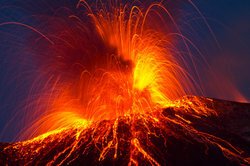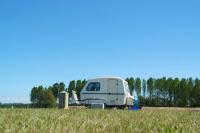How can you protect yourself from volcanic eruptions?
Anyone who considers volcanoes to be the largest show in the world has to accept that admission is not free. Again and again there are reports of destruction, ash clouds and deaths in volcanic eruptions. Since such natural phenomena cannot be prevented, the question arises whether and how one can protect oneself from a volcanic eruption?

The earth around extinct, dormant and active volcanoes is very fertile. Many people have settled in the immediate vicinity. They consciously live with the risk of volcanic eruptions. Sometimes these appear suddenly and unexpectedly. People die in mudslides, gas eruptions and stone rain or clouds of ash.
Global volcanic eruption hazards
Volcanic eruptions do not only pose a threat to local people. Exploding volcanoes can destroy hundreds of square kilometers of land and even affect the world's climate.
- The Tambora volcanic eruption in Indonesia in 1815 killed over 90,000 people. Volcanic ash was hurled into the atmosphere. That led to climate change and famine. Historians refer to 1816 as the “year without a summer”.
- How vulnerable the modern world is can be seen when the ash clouds of active volcanoes reach the altitude of the jumbo jets and move around the earth. Air traffic is severely hindered. Happened after a volcanic eruption in Iceland in 2010. An air traffic ban was imposed.
How to protect yourself
Many people live right on top of a volcano. Even in Europe people do not give way to the dangers of the active volcanoes Etna, Stromboli and Vesuvius. Scientists warn of the unimaginable consequences of a sudden explosion. They don't have an absolute solution as to how one can protect oneself from this.
Many phenomena of the earth can be explained quite simply in the principles. In addition …
- Active volcanoes are observed on site, from the air and even from space. Volcanologists deal with the formation of volcanoes, how they can warn and protect people against volcanic eruptions. Other scientists are developing solutions to start eruptions in a controlled manner or to redirect lava flows.
- There are volcanoes in very different places by and in the sea (risk of tsunami), at high altitudes with ice and snow (formed by mud flows). They are dangerous to people in densely populated areas.
- Outbreaks can be recognized by certain signs and activities (earthquakes, bulges, uplifts). Evacuations can be initiated in good time. In some cases, there is the option of taking technical measures. Gas clouds or lava flows can ideally be diverted through incisions and drainages. The establishment of warning systems and the implementation of evacuation exercises offer a certain level of protection.
Incidentally, scientists expect a volcanic eruption in the Eifel in the future. Those who do not stay in endangered areas are of course the least dangerous.
How helpful do you find this article?



